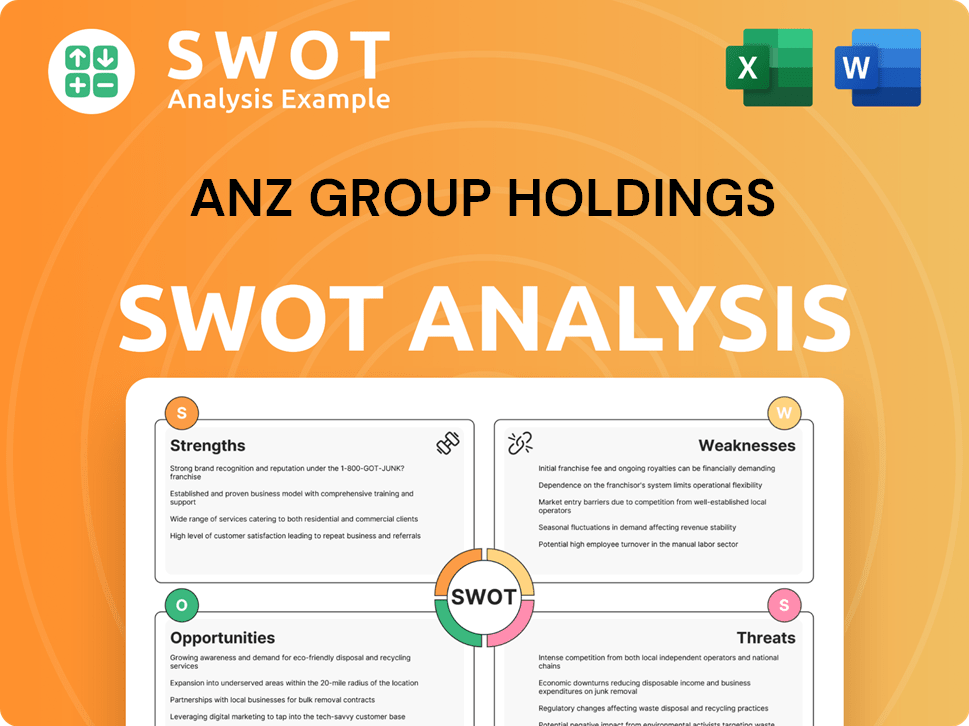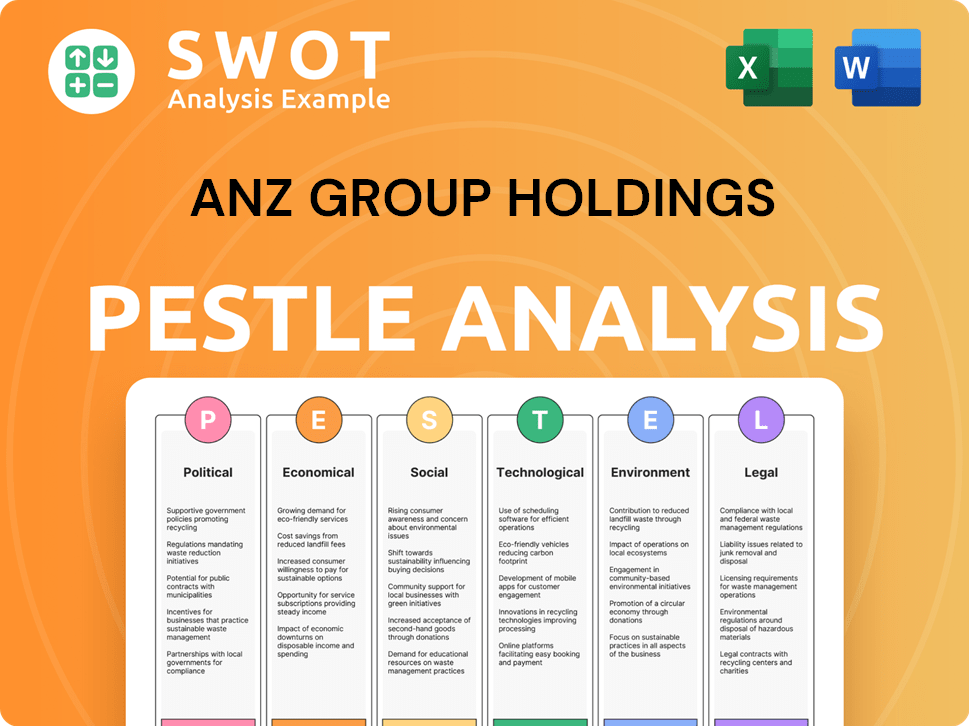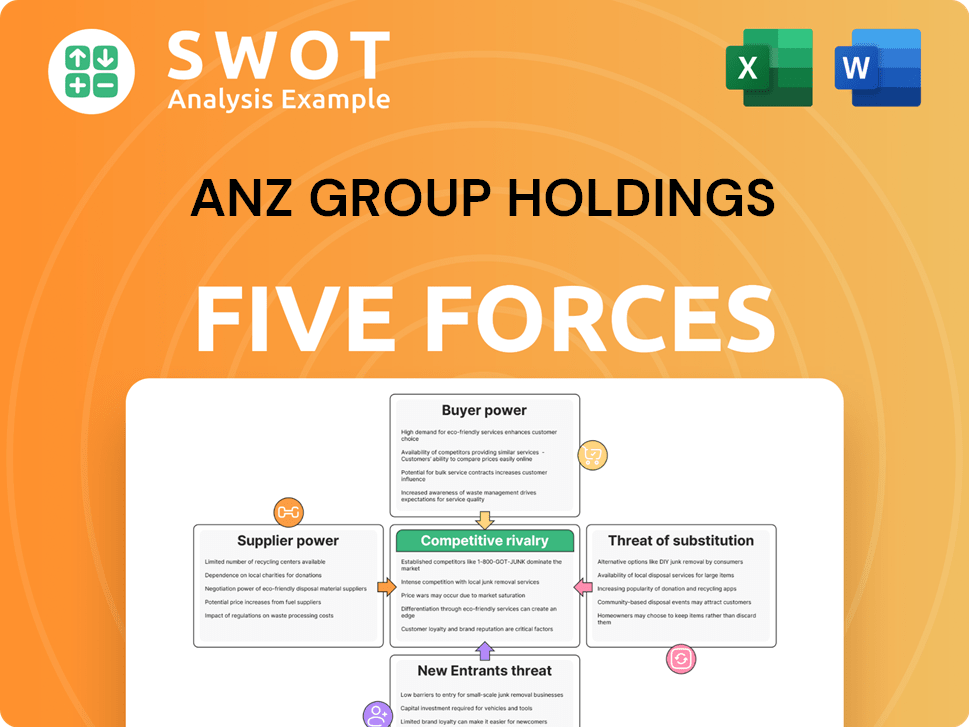ANZ Group Holdings Bundle
How Does ANZ Bank Stack Up in Today's Financial Arena?
ANZ Group Holdings, a cornerstone of the Financial services industry in Australia and New Zealand, has a rich history dating back to 1835. From its origins as the Bank of Australasia to its current status as a major international banking group, ANZ's journey reflects its commitment to the evolving needs of its customers and the markets it serves. Understanding the ANZ Group Holdings SWOT Analysis is key to navigating this complex environment.

This analysis provides a comprehensive competitive landscape analysis of ANZ Bank, exploring its position within the Banking sector Australia New Zealand and beyond. We'll dissect ANZ's market share and evaluate its competitive advantages, providing insights into its strategic initiatives and responses to the challenges it faces. Whether you're interested in ANZ Group Holdings financial performance review or the latest competitive intelligence on ANZ Bank, this is your guide to the financial battleground.
Where Does ANZ Group Holdings’ Stand in the Current Market?
ANZ Group Holdings maintains a strong market position within the Australian and New Zealand banking sectors. As one of Australia's 'Big Four' banks, it holds a significant share in retail, commercial, and institutional banking. The company's diverse product lines include home loans, personal loans, credit cards, deposits, wealth management, and services for businesses and institutional clients.
ANZ's core operations are primarily in Australia and New Zealand, serving a wide customer base. The bank has also expanded its presence in the Asia-Pacific region, including countries like Singapore, China, and India. This expansion aims to capitalize on the region's economic growth. ANZ has strategically shifted towards digital transformation, investing in online and mobile banking to enhance customer experience and operational efficiency.
For the first half of the 2024 financial year, ANZ reported a statutory profit after tax of A$3.09 billion, demonstrating its continued financial strength. This financial health positions it favorably against industry averages, supporting investment in growth and innovation. Further insights into the company's strategic direction can be found in the Growth Strategy of ANZ Group Holdings.
ANZ is a leading financial institution in Australia and New Zealand. It competes with other major banks for market share in various segments. The bank's market share is a key indicator of its competitive position within the banking sector.
ANZ's digital transformation efforts focus on enhancing customer experience and operational efficiency. Investments in online and mobile banking platforms are crucial. These initiatives help maintain a competitive edge in the digital-first financial environment.
ANZ's financial performance, including its profitability and capital ratios, reflects its strength in the market. The statutory profit after tax of A$3.09 billion for the first half of 2024 demonstrates its financial health. This strong financial position enables the bank to invest in growth and innovation.
ANZ is expanding its presence in the Asia-Pacific region. This includes operations in countries like Singapore, China, and India. The strategic expansion aims to capitalize on the region's economic growth and strengthen its global footprint.
ANZ's competitive advantages include its strong market position, diversified product offerings, and investment in digital transformation. The bank faces challenges from fintech competitors and the need to adapt to changing customer preferences and regulatory environments. Maintaining a competitive edge requires continuous innovation and strategic adaptation.
- Strong market position in Australia and New Zealand.
- Diversified product offerings across retail, commercial, and institutional banking.
- Strategic focus on digital transformation and customer experience.
- Expansion in the Asia-Pacific region to capitalize on growth opportunities.
ANZ Group Holdings SWOT Analysis
- Complete SWOT Breakdown
- Fully Customizable
- Editable in Excel & Word
- Professional Formatting
- Investor-Ready Format

Who Are the Main Competitors Challenging ANZ Group Holdings?
The competitive landscape for ANZ Group Holdings is defined by a mix of traditional banking giants, innovative fintech firms, and global financial institutions. This analysis examines the key players challenging ANZ across its core markets, focusing on Australia and New Zealand, and considers the evolving dynamics within the financial services industry.
Understanding the competitive environment is crucial for evaluating ANZ’s market position and strategic initiatives. This involves assessing direct competitors like the other major banks and indirect competitors such as fintech companies that are reshaping the financial services industry. The following sections detail the primary rivals and competitive pressures facing ANZ Group Holdings.
In Australia, ANZ faces intense competition from the 'Big Four' banks: Commonwealth Bank of Australia (CBA), Westpac Banking Corporation, and National Australia Bank (NAB). These banks compete across various financial products, including mortgages, business lending, and wealth management. The competition often manifests in aggressive pricing and innovative product offerings.
CBA is a major rival, often leading in market capitalization and customer satisfaction. CBA's strong digital platforms and extensive branch network give it a competitive edge. In the financial year 2024, CBA reported a cash net profit after tax of approximately $8.7 billion, reflecting its strong market position.
Westpac, one of Australia's oldest banks, is a key competitor, particularly in mortgages and business banking. Westpac's focus on customer experience and digital transformation is critical. In the first half of fiscal year 2024, Westpac reported a statutory net profit of $3.97 billion, highlighting its competitive stance.
NAB competes strongly, especially in business and agribusiness lending. NAB's strategic focus on customer service and digital innovation is evident. NAB's cash earnings for the first half of fiscal year 2024 were $3.9 billion, demonstrating its competitive strength.
Beyond the 'Big Four', ANZ faces indirect competition from non-bank lenders, fintech companies, and digital disruptors. Fintechs offer specialized services, while digital-only banks and payment platforms are pushing for innovation. These competitors challenge traditional banking models.
In New Zealand, ANZ's key competitors include ASB (a subsidiary of CBA), BNZ (a subsidiary of NAB), Westpac New Zealand, and Kiwibank. These banks compete through competitive rates, digital banking advancements, and localized marketing. The New Zealand banking sector is also seeing increased activity from fintechs.
ANZ faces several key competitive pressures, including pricing strategies, product innovation, and technological advancements. The home loan market is particularly competitive, with aggressive interest rates and cashback offers. Digital banking services are also a critical battleground, with investments in mobile apps and online platforms.
- Pricing Strategies: Competitive interest rates and fees across all products.
- Product Innovation: Continuous introduction of new financial products and services.
- Technological Advancements: Investments in digital platforms and customer experience.
- Fintech Disruption: Competition from specialized financial technology companies.
- Regulatory Environment: Compliance with changing financial regulations.
ANZ Group Holdings PESTLE Analysis
- Covers All 6 PESTLE Categories
- No Research Needed – Save Hours of Work
- Built by Experts, Trusted by Consultants
- Instant Download, Ready to Use
- 100% Editable, Fully Customizable

What Gives ANZ Group Holdings a Competitive Edge Over Its Rivals?
Understanding the competitive advantages of ANZ Group Holdings is crucial for a comprehensive competitive landscape analysis. ANZ's strengths are multifaceted, stemming from its established market presence, extensive infrastructure, and strategic focus areas. These advantages are critical in the financial services industry, particularly within the banking sector of Australia and New Zealand.
A key advantage for ANZ is its strong brand equity and customer loyalty. This trust is built on decades of service and a broad customer base, fostering sticky relationships. ANZ also benefits from substantial economies of scale, allowing it to achieve cost efficiencies in operations, technology, and marketing that smaller competitors cannot match. Its vast distribution network, encompassing physical branches, ATMs, and increasingly sophisticated digital platforms, ensures broad accessibility for its diverse customer segments.
Proprietary technologies and continuous investment in digital transformation are becoming increasingly crucial advantages. ANZ has been investing in its digital capabilities, aiming to enhance customer experience and streamline operations. This includes advancements in mobile banking, online loan applications, and data analytics to personalize offerings and improve risk management. Furthermore, ANZ's strong capital position and robust risk management frameworks provide a foundation of stability and resilience, which is particularly vital in volatile economic environments.
ANZ holds a significant market share in both Australia and New Zealand. Its long-standing presence has cultivated strong brand recognition and customer loyalty. This trust is a key differentiator in a competitive market.
ANZ leverages economies of scale to achieve operational efficiencies. This allows for cost-effective operations, technology investments, and marketing strategies. The scale also supports a large distribution network.
ANZ is actively investing in digital capabilities to enhance customer experience and streamline operations. This includes mobile banking, online loan applications, and data analytics. These initiatives are crucial for remaining competitive.
ANZ's strong capital position and robust risk management frameworks provide stability. This is particularly important in volatile economic environments. These factors contribute to ANZ's resilience.
ANZ's competitive advantages are critical for its success in the financial services industry. These advantages include a strong brand, operational efficiency, and digital innovation. Furthermore, ANZ's strategic focus on institutional banking and its extensive presence in the Asia-Pacific region also provide a unique advantage, allowing it to leverage cross-border trade and investment flows.
- Strong Brand and Customer Loyalty: Decades of service and a broad customer base foster sticky relationships.
- Economies of Scale: Enables cost efficiencies in operations, technology, and marketing.
- Extensive Distribution Network: Includes branches, ATMs, and digital platforms for broad accessibility.
- Digital Transformation: Investments in mobile banking, online applications, and data analytics.
- Financial Stability: Strong capital position and robust risk management frameworks.
ANZ Group Holdings Business Model Canvas
- Complete 9-Block Business Model Canvas
- Effortlessly Communicate Your Business Strategy
- Investor-Ready BMC Format
- 100% Editable and Customizable
- Clear and Structured Layout

What Industry Trends Are Reshaping ANZ Group Holdings’s Competitive Landscape?
The financial services industry is experiencing significant transformations, primarily driven by technological advancements, regulatory changes, and evolving consumer preferences. These factors are reshaping the competitive landscape for ANZ Group Holdings (ANZ Bank), creating both challenges and opportunities. The need for continuous innovation and adaptation is paramount for maintaining a strong market position.
ANZ Group faces risks from agile fintechs and digital-only banks, increased regulatory scrutiny, and global economic uncertainties, including inflation and interest rate fluctuations. However, the company can leverage its brand and customer base to expand its digital offerings and tap into sustainable finance and emerging markets. Strategic partnerships and a focus on customer-centric models will be crucial for future growth.
Technological advancements, including AI, blockchain, and cloud computing, are reshaping financial service delivery. Regulatory changes, such as stricter capital requirements and consumer protection laws, are increasing compliance costs. Consumer preferences are shifting towards personalized, digital-first banking experiences, driving innovation in service delivery.
The rise of fintechs and digital-only banks threatens to erode market share. Increased regulatory scrutiny and compliance costs can impact profitability. Global economic uncertainties, including inflation and interest rate fluctuations, could affect credit quality and demand for financial products.
ANZ can expand its digital offerings, incorporating AI for customer service. The growing demand for sustainable finance and ESG-compliant products presents a new market. Expanding its presence in emerging markets within the Asia-Pacific region offers substantial growth potential.
Focus on innovation, operational efficiency, and sustainable practices. Strategic partnerships with fintechs to broaden service offerings. Continued commitment to customer-centric models and digital integration to remain competitive and capture future growth.
The competitive landscape analysis of ANZ Bank requires understanding its position relative to key rivals, including both traditional banks and emerging fintechs. Key factors include market share, digital innovation, customer service, and financial performance. For example, in 2024, the Australian banking sector saw increased competition in digital banking services, with ANZ and its competitors investing heavily in technology and customer experience.
- Market Share: ANZ's market share in Australia and New Zealand is a critical metric, constantly evolving with competitive pressures.
- Digital Innovation: The adoption of AI and blockchain technologies is vital for enhancing service offerings and operational efficiency.
- Customer Service: Personalized banking experiences and seamless digital interfaces are becoming increasingly important.
- Financial Performance: Analyzing profitability, revenue growth, and cost management provides insights into ANZ's overall health.
ANZ Group Holdings Porter's Five Forces Analysis
- Covers All 5 Competitive Forces in Detail
- Structured for Consultants, Students, and Founders
- 100% Editable in Microsoft Word & Excel
- Instant Digital Download – Use Immediately
- Compatible with Mac & PC – Fully Unlocked

Related Blogs
- What are Mission Vision & Core Values of ANZ Group Holdings Company?
- What is Growth Strategy and Future Prospects of ANZ Group Holdings Company?
- How Does ANZ Group Holdings Company Work?
- What is Sales and Marketing Strategy of ANZ Group Holdings Company?
- What is Brief History of ANZ Group Holdings Company?
- Who Owns ANZ Group Holdings Company?
- What is Customer Demographics and Target Market of ANZ Group Holdings Company?
Disclaimer
All information, articles, and product details provided on this website are for general informational and educational purposes only. We do not claim any ownership over, nor do we intend to infringe upon, any trademarks, copyrights, logos, brand names, or other intellectual property mentioned or depicted on this site. Such intellectual property remains the property of its respective owners, and any references here are made solely for identification or informational purposes, without implying any affiliation, endorsement, or partnership.
We make no representations or warranties, express or implied, regarding the accuracy, completeness, or suitability of any content or products presented. Nothing on this website should be construed as legal, tax, investment, financial, medical, or other professional advice. In addition, no part of this site—including articles or product references—constitutes a solicitation, recommendation, endorsement, advertisement, or offer to buy or sell any securities, franchises, or other financial instruments, particularly in jurisdictions where such activity would be unlawful.
All content is of a general nature and may not address the specific circumstances of any individual or entity. It is not a substitute for professional advice or services. Any actions you take based on the information provided here are strictly at your own risk. You accept full responsibility for any decisions or outcomes arising from your use of this website and agree to release us from any liability in connection with your use of, or reliance upon, the content or products found herein.